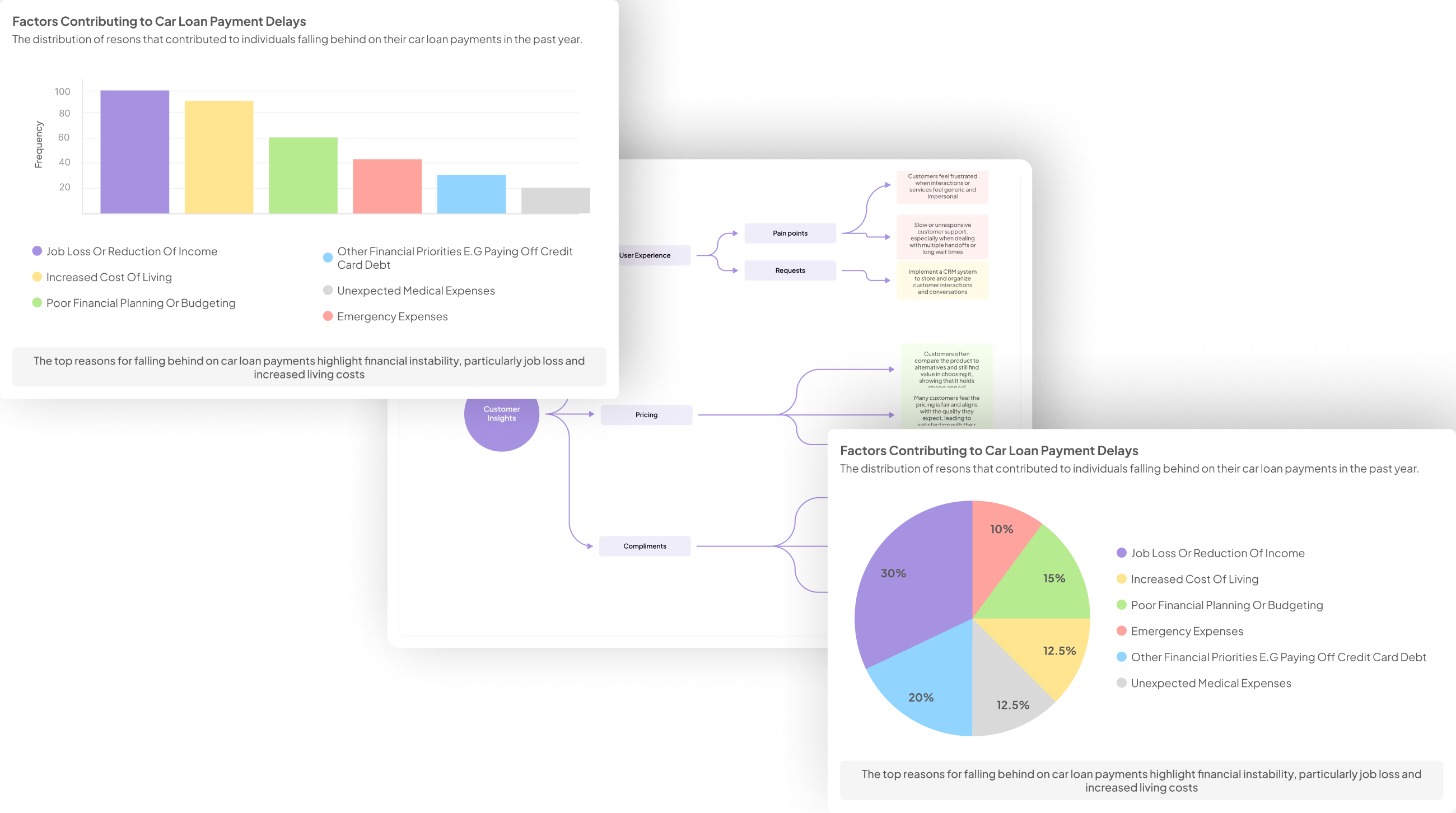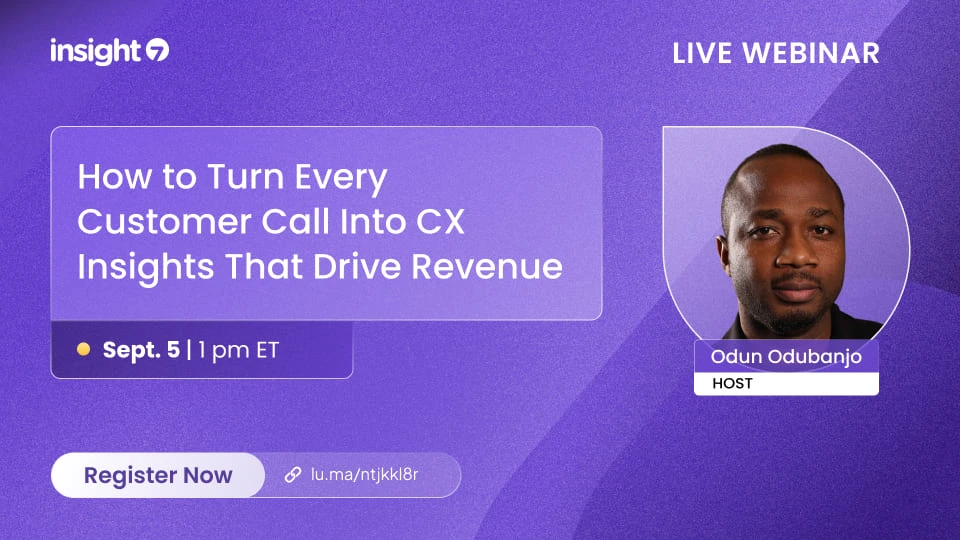Customer Driven Analytics: Comprehensive Overview
-
Bella Williams
- 10 min read
Customer insights analytics play a crucial role in understanding the complex relationships between consumers and brands. As businesses strive to meet ever-evolving customer needs, the ability to analyze and interpret data is paramount. This section provides a comprehensive overview of customer insights analytics, exploring its methods and significance in today's competitive marketplace.
In this introduction, we will delve into the core principles of customer insights analytics. The focus will be on uncovering consumer behaviors and preferences through systematic data collection and analysis. By grasping the nuances of customer interactions, businesses can tailor their offerings effectively, fostering a deeper connection and driving loyalty among their customer base.
Generate visualizations from your qualitative data. At Scale.

Harnessing the Power of Customer Insights Analytics
Customer Insights Analytics serves as a pivotal tool for understanding consumer behavior and preferences. This analytical approach allows businesses to gather valuable data, revealing what drives customer decisions and how they engage with products or services. By effectively harnessing these insights, organizations can tailor their offerings, enhancing customer satisfaction and loyalty.
To maximize the benefits of Customer Insights Analytics, a structured approach is essential. First, businesses must focus on gathering qualitative and quantitative data through various channels, such as surveys and customer interviews. This process can uncover pain points and desires, offering a comprehensive view of the customer experience. Next, synthesis of this data into actionable insights allows organizations to develop strategies that resonate with their target audience. Finally, continuous monitoring and adaptation of strategies based on evolving customer insights ensure sustained engagement and competitive advantage, reinforcing the commitment to a customer-centric approach.
Understanding Customer Behavior
Understanding customer behavior is a fundamental aspect of Customer Insights Analytics. It involves observing and interpreting how customers interact with products and services, enabling businesses to gain deeper insights into their preferences. By analyzing behavioral patterns, organizations can predict future trends and craft tailored offerings that resonate with their target audience.
In this process, it's vital to recognize various factors influencing customer decisions. These factors may include psychological triggers, social influences, and economic conditions. By collecting data through surveys, interviews, and customer interactions, companies can identify key insights that drive consumer behavior. Furthermore, analyzing this data within context allows businesses to adapt their strategies, ensuring they meet customer needs effectively. Ultimately, understanding customer behavior offers a pathway to building lasting relationships and driving success through data-informed decision-making.
Collecting and Analyzing Data
Collecting and analyzing data is fundamental for driving customer insights analytics. By systematically gathering data from diverse sources, businesses can obtain a clearer picture of customer behavior. Understanding which data points are most relevant paves the way for improved decision-making and the identification of trends.
To effectively analyze the collected data, it is crucial to implement various analytical techniques. Here are key aspects to consider:
Data Organization: Properly categorizing and storing data makes it more manageable. Streamlining data allows for easier access and analysis.
Identifying Patterns: Employ analytical tools to explore customer feedback, looking for recurring comments or sentiments. Recognizing patterns can reveal unique insights.
Comparative Analysis: Compare data across different timeframes or segments, such as geographic locations, to uncover actionable trends.
Visualization Tools: Utilize dashboards and visual aids for clearer understanding and presentation of insights.
By effectively collecting and analyzing data, businesses can harness customer insights analytics to create strategies that resonate with their audiences and drive growth.
Evaluate Performance on Customer Calls for Quality Assurance.
Implementing Customer Driven Analytics
Implementing Customer Driven Analytics requires a structured approach focused on delivering actionable insights. First, organizations must identify key metrics that align with their business objectives. This ensures that the analytics efforts are aimed at measuring aspects most relevant to customer engagement and satisfaction. Once these metrics are established, the next step involves leveraging analytical tools capable of processing the data effectively. These tools can transform raw data into meaningful reports that highlight trends and opportunities.
In addition to these initial steps, integrating feedback mechanisms is essential for understanding real-time customer sentiments. By encouraging customer participation through surveys or direct interviews, organizations can collect valuable insights that guide strategy changes. Adapting strategies based on customer insights not only enhances service offerings but also strengthens the customer relationship. This iterative process fosters continuous improvement, helping businesses stay attuned to evolving customer needs.
Steps to Actionable Insights
To transform data into actionable insights, begin by identifying key metrics that align with your objectives. These metrics will serve as a benchmark, guiding your analytical efforts. Once established, it becomes easier to interpret the data and understand patterns that reveal customer preferences and behaviors. For effective implementation, analytical tools play a crucial role in uncovering these insights. Select tools that facilitate data visualization and simplify complex analytics, ensuring that insights are easily comprehensible to all stakeholders involved.
Another essential step is integrating feedback mechanisms throughout the customer journey. Actively seek customer input to enrich your understanding of their experience and pain points. Consistently gathering feedback allows you to adapt strategies in response to changing customer needs. By following these steps, you can efficiently navigate the path to actionable insights through Customer Insights Analytics, ultimately empowering your organization to make informed decisions that enhance customer satisfaction and drive growth.
Step 1: Identify Key Metrics
Identifying key metrics is a foundational step in the process of Customer Insights Analytics. This stage involves determining the parameters that most effectively measure customer behavior and sentiment. By establishing these metrics, organizations can track progress toward their goals and uncover meaningful insights that drive decision-making.
Start by focusing on quantifiable metrics such as customer satisfaction scores, retention rates, and conversion rates. Alongside these, qualitative insights gained from customer feedback and interactions can provide depth to the data. For instance, analyzing patterns in customer communications can reveal areas for improvement and innovation. Combining these diverse analytics fosters a comprehensive understanding of the customer journey, allowing businesses to make informed decisions and optimize their strategies effectively.
In this way, measuring key metrics enables organizations to learn from their customers, enhancing the overall effectiveness of their services and products. Always remember, the relevance of the metrics chosen is key to achieving actionable insights that can lead to significant advancements in customer-focused strategies.
Step 2: Leverage Analytical Tools
Analytical tools play an essential role in converting raw data into meaningful customer insights. By utilizing these tools, businesses can effectively sift through vast amounts of information to identify patterns and trends that are invaluable for decision-making. This process is crucial to understand customer preferences and behaviors, which ultimately drives product and service enhancements.
To maximize the effectiveness of customer insights analytics, consider the following approaches:
Data Visualization: Utilize graphs and dashboards to clearly present data trends. A visual representation makes it easier to identify key customer behaviors at a glance.
Segmented Analysis: Break down data into specific demographics to gain targeted insights. This approach allows for personalized strategies that cater to different customer segments.
Comparative Analysis: Evaluate data sets from various locations or time periods to identify distinctions and similarities. Understanding these differences can offer valuable insights into regional preferences or shifts in customer behavior over time.
Feedback Integration: Use customer feedback as a powerful tool for refining products. Analyzing feedback helps in forming a more comprehensive understanding of customer sentiments.
By systematically applying these techniques, businesses can transform customer insights analytics into actionable strategies, fostering deeper connections with their audiences.
Step 3: Integrate Feedback Mechanisms
Integrating feedback mechanisms into your customer insights analytics is a crucial step. This process involves gathering input from customers, which provides vital information about their experiences and expectations. Feedback can come from various sources, including surveys, social media, and direct interactions. By systematically collecting this data, organizations can uncover trends, preferences, and pain points that shape customer behavior.
Once feedback is integrated into analytics frameworks, it becomes easier to identify actionable strategies for improvement. Establishing regular feedback loops ensures that customer insights remain current and relevant. This iterative approach allows businesses to adapt their offerings dynamically, ensuring alignment with customer needs. Overall, feedback mechanisms empower organizations to transform passive observations into proactive adjustments, creating a customer-centric environment. Incorporating these insights is essential for making informed decisions, which in turn enhances customer satisfaction and drives growth.
Adapting Strategies Based on Insights
In the realm of Customer Insights Analytics, adapting strategies based on insights is essential for ongoing success. Organizations must continuously examine the information gathered from customer interactions to refine their approaches. This process involves analyzing trends, understanding buyer personas, and identifying pain points. By interpreting these insights, businesses can not only meet customer expectations but also anticipate future needs.
In practical terms, there are several key strategies to implement. First, organizations should prioritize gathering comprehensive data across various touchpoints. This helps create a well-rounded understanding of customer behavior and preferences. Second, timely adjustments can be made based on the insights derived from data analytics, such as tweaking marketing campaigns or product offerings. Finally, fostering an agile culture allows teams to iterate quickly in response to new findings, ensuring the organization remains responsive and competitive. Adopting these strategies helps in building a customer-centric approach, leading to better engagement and satisfaction.
Conclusion: The Future of Customer Insights Analytics
The future of Customer Insights Analytics promises significant advancements that will enhance how businesses understand their customers. As technology evolves, organizations will increasingly harness artificial intelligence and machine learning to glean deeper insights from vast amounts of data. This transformation not only improves decision-making but also fosters more personalized customer experiences.
Moreover, as companies become more customer-centric, they will prioritize gathering real-time feedback and adapting their strategies accordingly. Embracing these trends will empower brands to stay ahead in competitive markets and meet the ever-changing needs of their consumers. The integration of advanced analytics tools will further streamline the process, ensuring businesses thrive in the age of data-driven insights.







